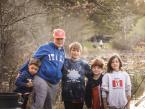Linda Despres, the chief scientist aboard the Albatross IV, has a haunting memory of visiting Georges Bank as a 23-year-old scientist.
"I have this picture in my mind of Georges Bank at night and seeing the lights of over 50 ships going back and forth across the horizon," she says.
But on this trip three decades later, the nights are dark. On this particular night on the eastern end of Georges Bank, the lights of only six ships are visible on the horizon.
"In my lifetime, I have seen the difference between what was then and what is now," Ms. Despres says.
In fact, Ms. Despres has spent more days at sea than any other scientist in the nation. She has worked for the National Marine Fisheries Service for 32 years and logged 1,400 days at sea.
Considered among the most well-regarded seagoing scientists, she is a stickler for details, according to Tom Azarovitz, a former chief of the survey branch of the National Marine Fisheries Service. Much of the work she has done has been passed along not only to federal fisheries scientists, but also to university scientists who are studying the status of fish stocks.
"She exemplifies the whole program," Mr. Azarovitz says. "And she is a cheerleader. Out there on the sea she works well with the scientists and is especially good at getting the young scientists working on the right track."
Ms. Despres, who has a sharp sense of humor, barks orders to the scientists about how best to organize their six-hour shifts. She reviews the catch report of the previous shift on a computer screen in the laboratory.
Among the changes she has seen over the years: The abundance of cod present decades ago on Georges Bank and in the Gulf of Maine has almost completely disappeared.
She also notes that navigation technology now can put a boat back on the same spot where it caught fish the year before. "The technology has changed tremendously in my lifetime," she says.
She grew up in Brunswick, Me. Her father ran a tuna fishing boat from Bailey Island, near Portland, a 36-foot boat named the Linda Gal.
"I grew up loving Jacques Cousteau and watching Lloyd Bridges on Sea Hunt," she says.
She remembers going with her father to Casco Bay as a young teenager. In a daylong trip, they harpooned bluefin tuna in Mackerel Cove. She speaks of the past as though it was just yesterday.
As bluefin tuna became more scarce, she remembers, the annual Bailey Island tuna tournament of her youth evolved into a big fish tournament.
"I was 13 years old," she says. "I remember when tuna sold for three cents a pound. There was such a waste of protein. If you got a 600-pound bluefin, you would take the carcass back out to sea and dump it. I didn't know that bluefin tuna could be as small as a football until I moved down to the Cape. Back then the smallest we saw was 450 pounds."
When she was 20 years old, Ms. Despres volunteered at the Maine Department of Marine Resources. She remembers sorting shrimp at a wet lab overlooking Boothbay harbor.
In 1973, she began working for the National Marine Fisheries Service out of Woods Hole.
"In those years, working for the NMFS meant you went out on Soviet, French and East and West German ships," she recalls. "The research vessels were as long as 300 feet."
Being a woman at sea was clearly an oddity in those years.
"There were so many things we had to prove," Ms. Despres says. "We had to prove we didn't get seasick, that we could move fish like anyone else and that we could live in spartan conditions."
Many of those trips were to Georges Bank, once the most productive fishing ground in the world.
Fishing boats from around the world came to harvest what they could. Prior to the 1982 establishment of the Hague Line - a line dividing the bank into exclusive sections for the United States and Canada - no restrictions existed on the take for ocean-going fishing factory ships.
But by agreement with the United States, each foreign fleet was accompanied by an ocean-going research vessel. The vessels, perhaps former factory trawlers, measured as much as 300 feet in length.
Ms. Despres remembers being an observer on the Soviet research vessel Belogorsk.
"I spent 39 days altogether on the Belogorsk," she says. "They would catch pelagic fish, herring, mackerel and squid. They would put their vessel at our disposal to do research in exchange for some allocation of fish that they could take back home."
Prior to the establishment of the 200-mile limit, foreign fishing fleets could go wherever they wanted. "In those days they harvested mackerel, herring and squid," Ms. Despres says.
"I was only 23 years old at the time," she adds. "I didn't understand the politics involved."
Looking back over her years at the fisheries service, she continues:
"I have seen the cycle. I have seen it when sand lances were so abundant. Silver hake were everywhere. I have seen haddock drop down to nothing and now to become very abundant. I haven't seen barn door skates for 19 years and now we get them quite often."
To all arriving scientists, Ms. Despres also offers a practical piece of advice for life on the rolling ocean. "One hand for the ship, one hand for yourself," she smiles.






Comments (1)
Comments
Comment policy »